The medieval period, spanning roughly from the 5th to the 15th century, was a time of great social, political, and economic transformation in Europe. Central to this era was the rise of feudalism—a hierarchical system that shaped every aspect of daily life. At the heart of feudal society were the various jobs and occupations that sustained communities, from noble lords and skilled artisans to humble peasants and wandering minstrels. Understanding these roles offers a fascinating glimpse into the structure and rhythm of medieval life.

Exploring the wide range of medieval jobs reveals how each role contributed to the functioning of feudal society. From the skilled blacksmiths, carpenters, and craftsmen who supplied essential tools and goods, to farmers, bakers, and winemakers who fed the population, every occupation played a vital part. Even entertainers, scribes, and soldiers held important positions that shaped both daily life and larger social structures. This page provides a detailed look at the most significant medieval jobs, offering insights into the responsibilities, skills, and social standing of those who lived and worked during this transformative era.
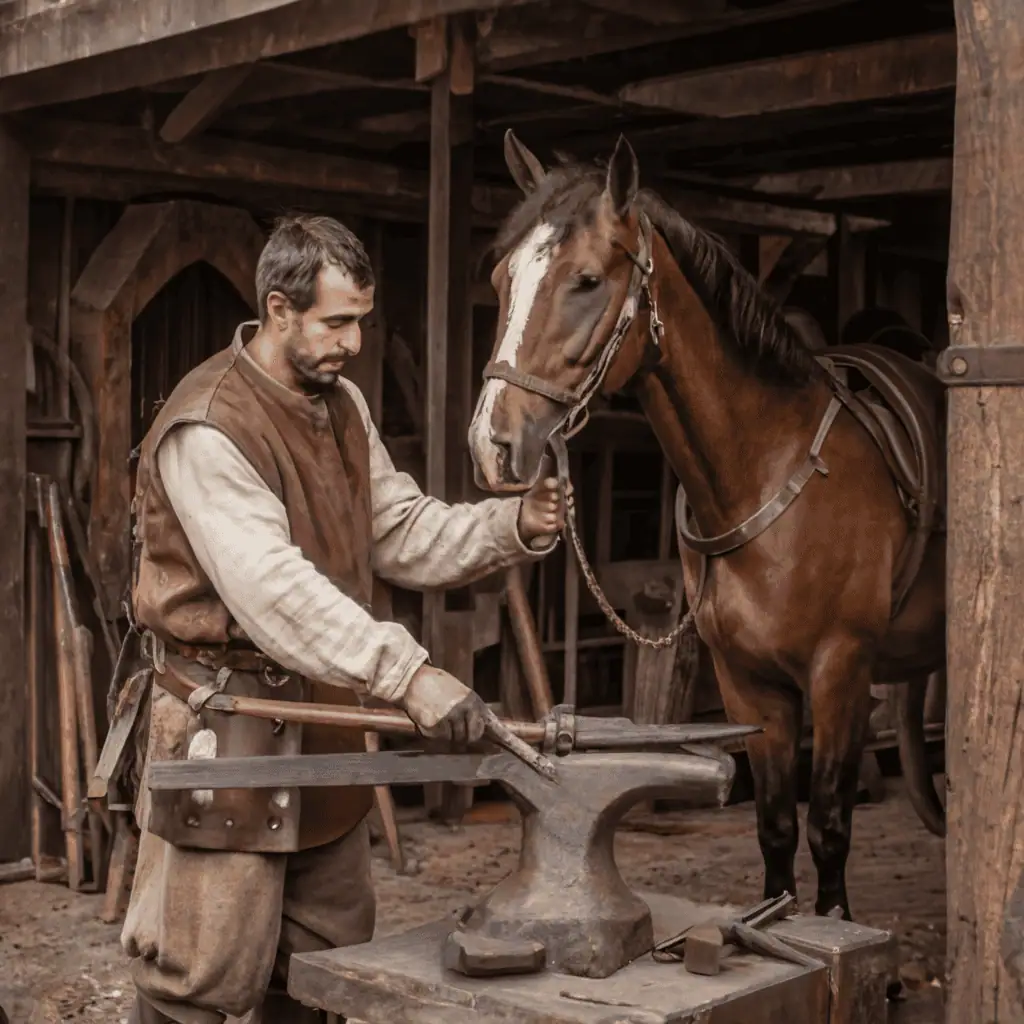
Medieval Jobs Manor Estate Related Jobs Types
- Baker
- Blacksmith (Made Horse Shoes and Many Important Items)
- Brewer (Made Ales)
- Clergyman
- Cooper (Made Various Storage Casks)
- Farmer
- Farm hand (Serf)
- Locksmith (Made Various Locks and Keys)
- Miller (Made Bread)
- Shoemaker (Made and repaired Shoes)
- Winemakers (Made Wine)
- Roofers (Made & Repaired Roofing)
- Wheelwright (Made and Repaired Cart Wheels)
- Reeve (Oversaw Work of Serfs)
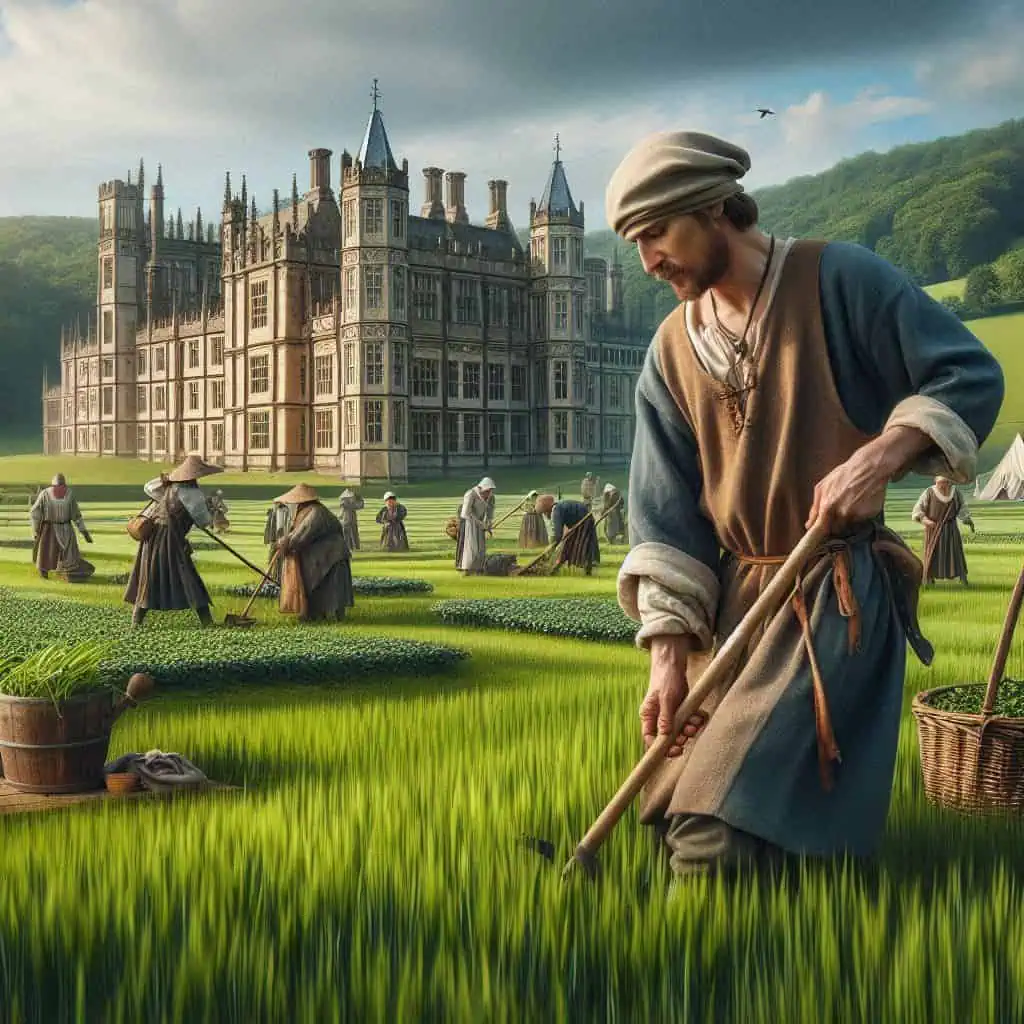
Craftsmen Important Trades During Medieval Times
- Blacksmiths
- Carpenters
- Cobblers (Shoemakers)
- Stonemasons
- Wheelwrights

There were also many Medieval Jobs directly related to warfare activities such as
- Armorers (Made Armour & Shields)
- Bowyers (Made Longbows)
- Castle Guardsmen (Protected Castles)
- Fletchers (Made Arrows)
- Swordsmith (Specialist Smith who Forged Swords)

Skilled Craftsmen Jobs
Medieval craftsmen were highly skilled workers who specialized in creating a wide variety of essential products for daily life in medieval villages, towns, and cities. Their craftsmanship also played a crucial role in producing items needed for warfare, making their contributions invaluable to society. These craftsmen typically underwent extensive training through long apprenticeships, learning their trade from experienced masters.
After successfully completing this rigorous training, they advanced to the status of journeymen, allowing them to work independently and further hone their skills. The dedication and expertise of these craftsmen not only supported the local economy but also helped maintain the social structure of the time, as their work was integral to both commerce and community life.

Craftsmen commonly joined a Guild and could become masters of their trade by completing a ‘masterpiece’ work that was accepted by the Guild as being worthy of a master craftsman.
Medieval Jobs List
Artist
During the medieval period, an artist was typically someone who created portraits or painted the likeness of individuals. Most artists worked in the service of wealthy patrons or nobility, producing commissioned works for personal or public display.
Artists were often handsomely rewarded for their work, and some, like Michelangelo and Leonardo da Vinci, were commissioned to create public works that showcased their skill and enhanced the prestige of their patrons. A wide variety of materials and artistic mediums were employed during the medieval era, reflecting both the creativity and technical expertise of these skilled craftsmen.

Blacksmiths
The carpenter and blacksmith were one of the most important occupations in the medieval period. Nearly all areas of life used iron and steel products and tools at the time. Such tools were used in warfare, farming, and a variety of other skilled occupations such as *Horse Shoes *Door Knockers *Metal Gates *Armour *Weapons *Tools *Torture Devices
A blacksmith would forge such tools in his workshop. In doing so, the smith used an anvil and a hammer to shape and forge various tools first melting into liquid form.

Bell founders
Bell Founders made bells of all types, bells were in high demand during medieval times for many buildings such as Churches and Clocktowers.

Specialist medieval craftsmen had to be very skilled to produce large quality bells that were cast in moulds. Bells also required fine tuning so that they would hit the correct pitch and harmonies required.
Belt & Buckle Maker
Like hats, belts were very popular in medieval times, belt makers were in demand to make a variety of belts for common people and nobility

Belt makers used a variety of cutting tools, skiving knives, and hole punches.
Calimala: Cloth Finishers and Merchants
The Calimala were an elite guild of cloth finishers that were based in Florence in Italy which became a very powerful city under the ‘House of Medici’.

The Calimala imported woolen cloth from France and other regions and used highly skilled techniques in which the cloth was dyed, stretched, fulled, calendared, and finished.
Candle Maker
Candlemakers were kept busy in medieval cities, towns, and villages as they offered an essential product to light medieval people’s homes and businesses.
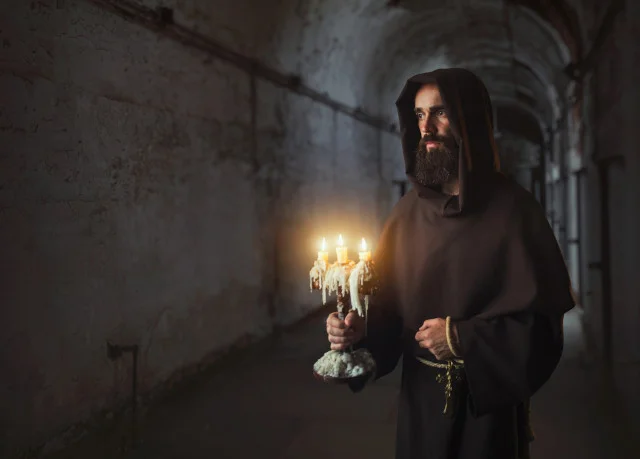
Candles were primarily used for illumination during the medieval period. They would be used at homes, churches, outdoor feasts, and in greater abundance on special occasions.
A candlemaker was the one who made these candles. Although most towns had their own candlemakers, notable estates of noblemen retained their own candlemakers. These would be responsible for harvesting the wax from the bees and using it to create candles.
Carpenters
Carpenters created useful products out of wood. They were important during the medieval ages as many important objects such as utensils, furniture, wagons, building structures required wooden parts and frameworks
These were created by a carpenter who could earn a very good wage from his occupation. Some carpenters were permanently attached to a wealthy person such as a nobleman or a king. The more intricate a carpenter’s work was, the more highly it was rewarded.

Cabinet Makers
Cabinet makers were carpenters who work in the specialism of making chests and trunks out of wood, they would have also made other products.

Cobblers (Shoemakers) Made & Repaired Shoes
Cobblers made and repaired shoes for everyday medieval people. Wealthy Medieval people such as the Nobility had their own shoemakers called Cordwainer. A Cordwainer made luxury shoes with various styles that were exclusive to the nobility.

Hatters: Hat Maker
Hats were very popular in medieval times and some form of headgear was worn by almost all people in medieval society. Various materials were used to make medieval hats, including wool, silk, linen, leather, cotton, etc.
Hatters were classed as skilled craftsmen and as such were part of a Guild
Tailors were also hired by nobility and rich merchants to make their clothes as well as medieval hats. Thus customized hats with elaborate styles could be ordered.

The common people and the peasantry, on the other hand, usually purchased ready-made hats or sometimes made them at home. Peasant women could sew and embroider them when required.
Moneyers: Coin Makers
Moneyers during medieval times had the exclusive task of minting coins as per the instructions of the king. Sometimes they would remain idle in which case some of the moneyers worked with goldsmiths. During the late medieval times, the status of a moneyer was recognized as a respectable medieval Craftsman.

- A moneyer worked in a workshop commonly in a medieval city or town
- Severe punishments were given to a moneyer if he broke the rules of production
- A moneyer worked on a supply and demand basis, sometimes they were very busy
- During quiet times a medieval moneyer who work for a Goldsmith to make an income
- A moneyer was a respected craftsman in medieval society
Cooper
Coppers made barrels, wooden casks, and other similar containers. The Cooper was a very skilled and important craftsman in medieval times, Casks were in high demand to transport dry and wet products commonly food, but were difficult to produce and required considerable skill to make.

Some Coopers were directly employed by Breweries and made the Casks that were used to transport Ales and wines.
Goldsmiths: Jeweller
As artisans, goldsmiths enjoyed very significant prestige in medieval Europe. They typically worked not just on gold but also on silver and occasionally used gems in their works. In most major medieval European cities, goldsmiths organised as guilds that held significant sway and political power.

Given their affluence, goldsmiths also often acted as bankers since they had a ready stock of well-secured gold at most times.
Locksmith
A medieval Locksmith made various Locks and Keys. Locksmiths were in high demand during the medieval period creating many types of locks, the most popular of these was the fetterlock, which was used to secure livestock.

Medieval Locksmith
Medieval homes often had several locks on their doors especially if they were important buildings such as armories and treasuries that stored valuable items.
Roofers
Medieval roofers used different materials to make and repair medieval buildings’ roofs, in earlier medieval periods the thatched roof (straw) was popular and needed a different skill set to later medieval roofing materials such as clay tiles, wooden shingles, and stone slabs.

These new roofing materials were introduced by law in the 13th Century as they were less likely to catch fire which helped to stop fires from spreading through medieval towns and cities which were mainly made of wood.
Stone Masons
Stonemasons were involved in the building of stone medieval buildings and castles and creating fancy stoneworks for buildings and castles such as created gargoyles. A stonemason was a skilled craftsman who would break, cut, and carve stones to be used in buildings.
Most stonemasons organized together as guilds. A mason was hired to carve and place stones in structures such as castles and churches. A quality stonemason with finesse in work was highly sought after and could earn decent money.

Like Carpenters Stonemasons were highly skilled and very Important trades in medieval times.

Tanner
Tanners use the skins and hides of animals to create leather products using a messy process called tanning, in a building called a tannery that is usually located on the outskirts of cities and towns due to the stench created by this process.

Tanners used a special process known as tanning to make leather products from animal skins such as
- Bags
- Boots
- Harnesses
- Leather Armour
- Scabbards (Sword Protective Sheath)
Tanning was a dirty, messy, and foul-smelling occupation that was often frowned upon by medieval people of higher status, however, the ancient art of tanning was very skilled, and as such tanners were classed as craftsmen and belonged to Guilds.

Weavers
There were many types of weavers in medieval times who made a wide range of cloth products.

Medieval weavers made all kinds of items made from cloth such as clothing from materials such as wool, flax, hemp, and sometimes silk. Weavers were classed as urban craftsmen and had to become a member of a guild that established a standard of quality for the work they produced.
Medieval weavers often worked at Home and used two types of looms
- Warp-weighted looms (Earlier Medieval Periods)
- Horizontal looms (Later Period 10 – 11th Century)
Wheelwright
A medieval wheelwright was in demand to make wheels for carriages and also repaired broken wheels, the name wheelwright means in Old English ‘Shaper of Wood’.

Carts of various types were in demand and carriages were popular modes of transport with wealthy medieval people such as Royals, Nobles, and wealthy merchants.
Armour & Weapons Related Jobs
- Armourers (Made Armour & Shields)
- Bowyers (Made Longbows)
- Fletchers (Fletching of Arrows)
- Swordsmith (Specialist Smith who Forged Swords)
Armourers
Armorers were part of a guild of master craftsmen who made body armour and shields for medieval knights and soldiers. Although an armorer was a type of blacksmith, he specifically focused on creating armor for the knights and noblemen who fought battles.
Suits of armor required a great degree of skill to create and were very expensive to buy, modern estimates consider a price of up to $100,000 to be accurate. Every suit of armor was designed to be specific to the dimensions and preferences of the individual wearer. So each suit was a unique project.

Blacksmiths made general products as well as armour and weapons, but as the medieval period progressed manufacturing processes became more advanced and complex, this gave rise to specialist smiths who worked only as ‘armorers’.

Armorers could also specialise in a certain part of body armour protection, there were armorers who just made helmets or shields for example.
Bowyers
Bowyers were specialist craftsmen who made Longbows which were used by Longbowmen (archers in medieval armies), they were in high demand during the many battles of the ‘Hundred Years War between England and France (Plantagenet Period)

This was the golden era of the English Longbowman who dominated the battlefield during the Battles of
- Crécy (1346)
- Poitiers (1356)
- Agincourt (1415)

Bowyers were master craftsmen and as such were members of a Guild.
The Bowyer commonly learned his ancient trade from his father, mastering the most important skill when making a longbow which was the bending called ’tillering’. The bending of a longbow needed to be very even, if the bow was not bent correctly it would simply snap when drawn.
Fletcher
Closely related to the craft of the bowyer was the art of arrow making which is far more complex than it may first appear. Fletchers were in high demand during the hundred years war between England and France (1337 – 1453) as they made the arrows used by the famous English longbowmen during the battles of *Crécy (1346) *Poitiers (1356) *Agincourt (1415)

Arrow makers sometimes made just the fletching of an arrow also called the ‘flight’, but also commonly made the whole arrow and Fletching.
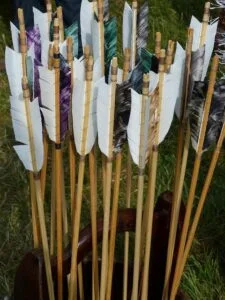
Arrows were commonly under a yard long and made from lightweight woods such as
- Aspen
- Ash
- Birch

Feathers were ‘Fletched’ to the base of the Arrow commonly
- Geese
- Swan
- Peacock

A nock or groove was cut into the base of the arrow into which the bowstring was placed and this held the arrow in position.

Swordsmith / Bladesmith
The sword, a mystical weapon and favourite weapon of the gallant knight was made by a specialist smith called a ‘swordsmith’ or ‘bladesmith’.

Swordsmiths were very skilled craftsmen who were in demand throughout the medieval period and formed their own guilds.

Weapons makers were in a constant struggle against advancements made in armour design, as the medieval period progressed sword technology advanced and the use of tempered steel in sword manufacture became more common around the 10th century.

The swordsmith would heat blocks of iron in a furnace, this allowed the swordsmith to work the shape of the sword, it was then rapidly cooled in water ‘quenched’ which created a hardened and tempered steel.

Medieval Jobs Related to Castles
- Executioner
- Guardsmen
- Page Boy & Squire
- Knight
Executioner / Hangman / Headsman
The executioner would be given a warrant that authorized him to behead prisoners for very serious crimes such as treason. It was the executioner and his assistants that administered torture in the dungeons of the castle and he acted in an official capacity.

Guardsmen
Castle Guards threw rocks, hot oil, and other projectiles from battlements at the top of the castle walls and towers onto besieging armies. Castle Guards may have been deployed as archers on the walls of the castle, commonly using crossbow weapons.

Castle Guards stationed around the Gatehouse poured boiling oil through murder holes at the castle’s gatehouse entrances and also used other weapons such as crossbows to protect these highly important areas of the castle.

Page Boy & Squire
Page Boy
In medieval Europe, a page or page boy was classed as being a young nobleman who left home at a very young age (around 7 years) to learn how to become a knight (assisting a Squire) in another royal or noble household.

Typical chores of a page included taking the lord’s messages to different other persons, tidying up the clothes and weapons of his lord, and serving the Lord in other ways such as by filling his wine cup at meals. Often the page was also required to aid the lord put on his armor and weaponry just ahead of a battle.

Squire
In the medieval period, a squire was someone who accompanied a knight as his shield and armor-bearer. Typically, a squire was a teenager and earned the title of Squire at the age of 14. He would then accompany the knight onto the battlefield, to prove his mettle and show his loyalty to the lord.

Before battles, the squire was also required to perform different tasks as his lord may require, such as readying the horse and preparing weapons.
Knight
Medieval knights had a closely intertwined relationship with the feudal system, which was clearly defined and structured. Knights typically served a high-ranking lord, who might grant them lands or income in return for loyalty and military service.
In turn, these lords owed allegiance to the king or a higher-ranking noble and were responsible for providing troops and military support during battles, reinforcing the hierarchical obligations that defined medieval society.
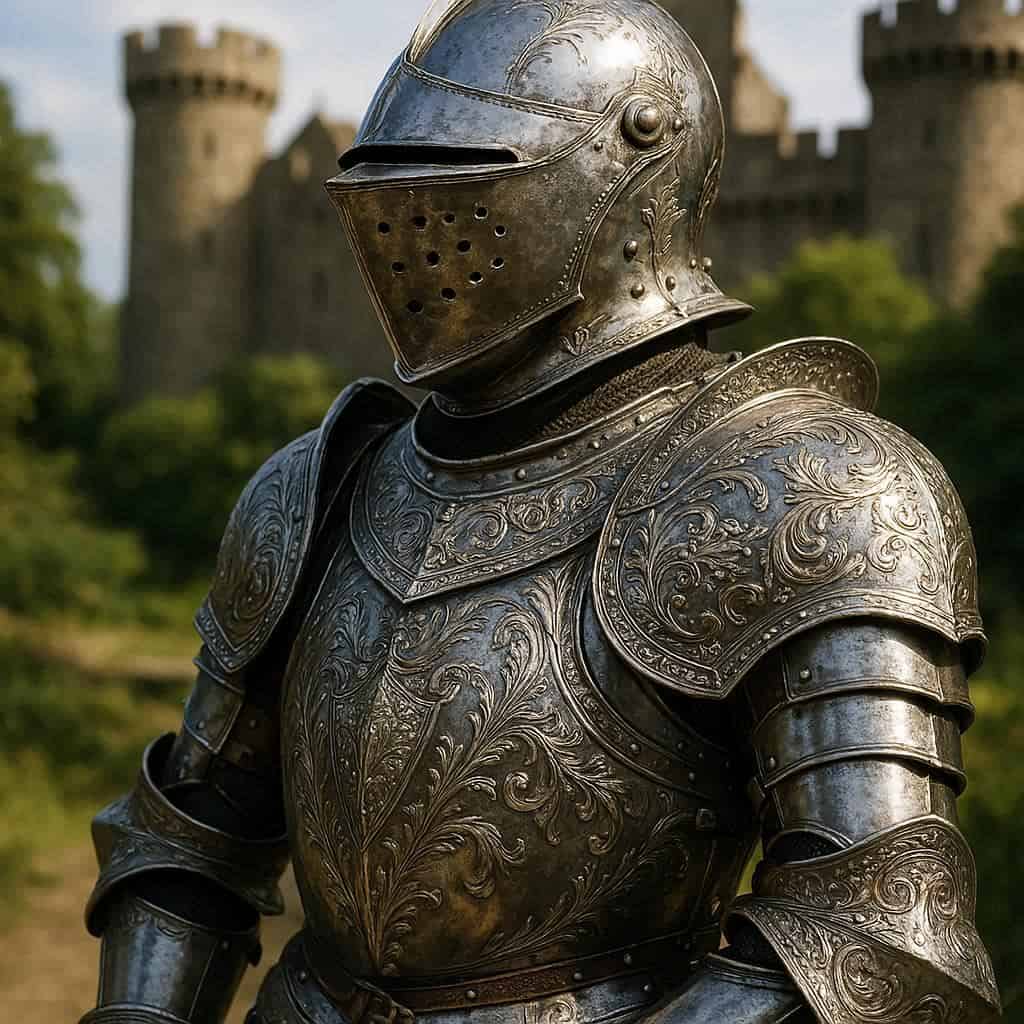
Medieval Jobs & Occupations in Medieval Cities, Towns & Villages

There were many jobs in medieval Cities, Towns, and Villages that were neither classed as crafts, but could be considered skilled or unskilled.
- Baker
- Butcher
- Cook
- Farmer – Farm Hand
- Grocer *Merchant
- Messenger
- Miller
- Tax Collector
- Winemaker
- Watchmen
Baker
A Baker was one of the most common occupations during the medieval period. A baker would bake and sell bread as well as other basic eatables made from flour.
In some parts of medieval Europe, bakers would sometime swindle the public by selling bread at a higher price. To counter this, kings would then promulgate decrees to punish such cheating.

Butcher
The Butcher was one of the most important people in medieval times, depending on whether the butcher resided in a medieval village, town, or city he may have actually slaughtered the animal himself, prepared the meat, and sold it in his shop.

Miller
A miller was someone who ground up the grains to make flour. Farmers who would grow wheat and other grains brought them to the miller.

The miller then ground them up to make flour which was then turned into bread and other eatables. Mills powered by water flowing under a building were typically used. These comprised of horizontal and vertical grinding stones which crushed the grains by applying weight to them while rotating.

Farmer & Farm-Hand (Serf)
During the medieval period, Europe was largely feudal and relied heavily on agriculture. As a result, farming was the main occupation of a large percentage of the population.
Most of the farmers were essentially Serfs who worked on the land of the Lord of the Manor or tenants who would be given land by the local lord who originally owned it.


They would till and cultivate it, reap crops and keep a share of the profits while giving the rest to the Lord. Yet there were other farmers who privately owned land. The amount of land a person owned was often seen to define his prestige and standing.

Winemaker
Winemakers played an important role in medieval times as they produced the wine that was very popular, they would grow and harvest the grapes and produce the wine which was stored in casks made by a cooper.

Medieval Jobs & Occupations *Entertainers
- Court Jester
- Jongleur *Musician & Entertainer
- Minstrel *Travelling Musician
- Trouvere * Poet Musician *Singer
- Troubador *Musician *Poet *Storyteller
- Waits *Musicians
Court Jester
A medieval court jester was a jester employed by the royal court for his performance and entertainment. This was a permanent position and the Court Jester had his own residence that was provided for him.

The medieval court jester could perform a variety of tricks other than telling jokes. For instance, his entertainment also included music, juggling, acting, clowning, etc
Jongleur: Musician & Entertainer
Jongleurs were entertainers in medieval France who were very similar to the trouvère. they were storytellers and general public entertainers.
Discover all the Important Jobs of Medieval People in the Middle Ages

Minstrel
A minstrel was essentially a medieval musician. Minstrels could play a variety of instruments, sing poetry and songs, and typically travel around from one place to another.

Some were permanently retained by wealthy noblemen and kings so that they could play when required. Minstrels recorded and popularized the heroic deeds of the knights of the medieval period. They would sing these from tavern to tavern, playing a key role in preserving information about many important historic events.
Trouvère (Troubadour) Poet – Musician – Singer
Trouvère were poet-composers who were very similar to Troubadours, they composed and performed lyric poetry during the high medieval period.

Waits: Musicians
Waits were very important during the medieval period and most cities and towns had a band of waits (Band of Musicians). Waits could be seen in most medieval towns and cities playing their instruments through the night and entertaining important visitors. These brightly dressed bands of musicians would play their music anywhere including outside medieval people’s homes.

Other Medieval Jobs & Occupations
Barrister
As the medieval age progressed, the laws of the land became more important and clearly defined. There was a need for someone to be able to interpret and argue with these laws.
This is why a barrister enjoyed an important role in the later medieval period. Initially, local parish priests would serve as barristers but in time, a whole separate class of independently educated barristers came into being. They would be educated in the King’s law and settle legal disputes through arbitration.
Barber-Surgeon – Provided haircuts, shaves, and basic medical care, including bloodletting and minor surgeries, playing an important role in both hygiene and health in medieval towns.
Town Crier – Announced news, proclamations, and warnings to townsfolk in public spaces, ensuring communication across villages and cities before printing was common.
Bridge Keeper / Gatekeeper – Managed entry points to towns, castles, and bridges, collected tolls, and maintained security, serving as an essential figure for trade and defense.
Water Carrier / Porter – Delivered fresh water and goods to households, inns, and marketplaces, a physically demanding but vital occupation for daily medieval life.
Rope Maker / Ropemaker – Produced ropes for ships, castles, and various construction purposes, using hemp or other fibers twisted into strong, durable cords.
Falconer – Trained and cared for birds of prey used in hunting by nobles, a specialized role that required patience, skill, and knowledge of birds’ behavior.
Almoner – Distributed charity on behalf of a monastery, church, or noble household, ensuring food, money, and aid reached the needy in the community.
Spinner – Created thread from wool, flax, or hemp, supplying the textile industry with the raw material needed for weaving cloth and garments.
Dyer – Applied colors to cloth, using natural dyes extracted from plants, insects, or minerals, transforming plain textiles into vibrant fabrics for clothing and trade.
Apothecary – Prepared and sold medicines, herbs, and remedies for the sick, combining knowledge of plants and early chemistry to care for the community.
Chamberlain – Managed finances, private chambers, and household affairs for a noble or royal household, ensuring smooth operation of daily domestic and administrative tasks.
Messenger – Carried important messages, letters, and documents between towns, castles, and courts, often traveling long distances under challenging conditions.
Frequently Asked Questions – Medieval Jobs
What were the most common jobs in medieval times?
The most common jobs in the medieval period included farmers (peasants), blacksmiths, bakers, carpenters, weavers, and masons. Most people lived in rural areas and worked the land under the feudal system, providing food or labor in exchange for protection.
What was the role of a blacksmith in medieval society?
A blacksmith was a crucial figure in medieval villages and towns. They forged tools, horseshoes, weapons, and armor using fire and metal. Their work supported both daily life and the needs of knights and soldiers.
Were there jobs specifically for women in the medieval period?
Yes, women held important roles such as midwives, spinners, brewsters (female brewers), servants, and textile workers. Noblewomen might manage estates or serve as healers or scribes in religious communities.
What did medieval knights do as a job?
A knight served as a mounted warrior and protector of a lord’s land. Beyond combat, knights upheld chivalric codes, managed manors, and acted as local leaders. In return, they received land or income from their lord.
What were some unusual or interesting medieval jobs?
Some lesser-known medieval jobs include Fletcher (made arrows), Gong Farmer (cleaned out privies and cesspits), Tinker (mended household metal items), and Almoner (distributed charity on behalf of a monastery or noble).
How did medieval people learn their trade?
Most trades were learned through apprenticeships. Young boys (and sometimes girls) would live with a master craftsman, training for years before becoming journeymen and eventually masters themselves in guilds.
